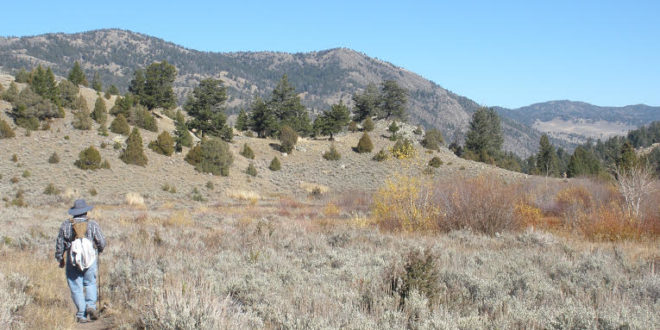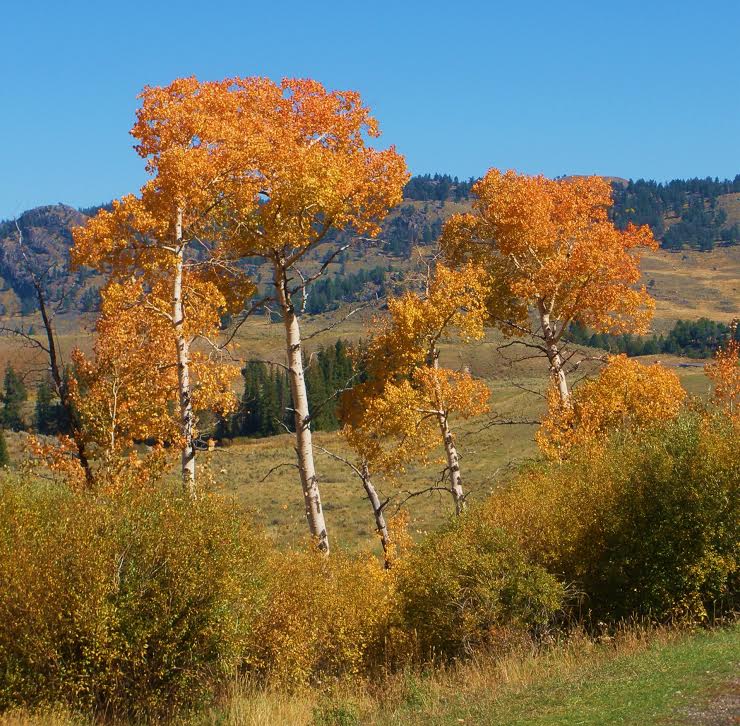It’s nice to get out on a fall weekend and visit my local park—Yellowstone.
Living in Livingston, it’s barely an hour to Gardiner and then into the park. The Northern Range, from Mammoth to Cooke City, has something going on all year-round—from wolf pups at the Slough Creek turnoff in summer; spring babies including bison, elk, and grizzly; and cross-country skiing in winter.
But fall is a special time on the Northern Range. The angle of sunlight changes and the aspens and cottonwoods blaze with color—the leaves glow orange and yellow, seemingly with an inner light.
That “animal” jam up ahead? There might not be a critter at all. Sometimes people pull over just because the colors are so breathtaking.
Mammoth to Tower is usually pretty sedate, but the traffic was heavier and little more impatient last week thanks to road construction on the section of Grand Loop Road between Norris and Mammoth. The section was closed Sept. 11 and will remain closed until the morning of Friday, Oct. 7. The Grizzly Lake, Solfatara, and Mount Holmes trailheads, located within the full closure zone, are likewise closed.
This time of year is great to get out and hike, especially if the weather stays mild.
An old favorite of mine is the Blacktail Plateau Trail. The trailhead is about about six miles east of Mammoth on the south side of the road. The trailhead leads to several trails, but I like to make an easy day hike out of hiking toward the suspension bridge over the Yellowstone River.
On a recent hike, the sky was bluebird-blue. A few flowers still clung to the edge of summer, and we heard a squirrel chatter at us, announcing to any and all concerned that trail mix-carrying humans were in the neighborhood. We chattered right back at him, “Hey, aren’t you supposed to be hibernating? It’s almost October!”
A few indications of fall were in the air, though. We spotted a National Park Service crew installing snow poles along the roadside. A slight coolness in the air, and the autumn sunlight, angled lower in the sky, casting a warm glow over the reds and golds of fall foliage, spoke of winter to come.
And even though the day said “august,” the calendar still says “late September,” so I packed along some just-in-case cold weather gear, including long underwear, a wool hat, extra wool socks (figuring they could act as either socks or mittens, if needed), a fleece jacket and an ancient Patagonia ripstop-nylon hooded anorak.
The pullover, always in my backpack, nearly weightless and highly compactable, fulfills the role of emergency warmth layer. On a good day, with its nonbreathing, nonpermeability, it’s invariably too hot to wear for more than about five minutes. It gets so hot so fast, I figure it could save my life if the weather turned cold, right? I call it my roasting-ass layer.
I’ve only used it once in a sudden turn of cold weather. A cold wind, dark clouds and a brief nearly-hail storm overtook us years ago on the descent down the Mount Washburn trail. I put on the anorak, and it was good. Until it wasn’t. The storm passed, the sun came out, and I got roasting-ass hot in a hurry.
On the Blacktail Plateau trail, the vistas are large and wide open. We had long views all the way around. A small herd of bison dotted the far-away hillsides. A trailside sign said there was a dangerous bear in the area, but there was no sign of it on a warm, wide-open afternoon. We did see some small, not terribly fresh tracks of a black bear where the trail got closer to Blacktail Deer Creek.
The trail ambles over low, long hills with some moderate ups and downs. About two miles in, the trail starts to descend where it will eventually hit the Yellowstone River. At the Yellowstone, a backcountry suspension bridge crosses the river. The trail meets the Yellowstone River Trail, which heads west along the river, back to Gardiner.
But we didn’t go that far that day. We had a long, slow grade to hike back up, so we turned around. It was hard to remember that dusk would come earlier than the weather would suggest. We didn’t want to be on the trail in the early evening and possibly startle a large, hungry, near-sighted bear in the weakening light.
When we got home, I went online to a calorie- and exercise-tracking website, and entered a five-hour hike with a less than 10-pound pack. The program calculated I had expended more than 3,000 calories. Good thing we had a chance to replace some of those calories with an obligatory post-hike pizza in Gardiner.
 Yellowstone Insider Your Complete Guide to America's First National Park
Yellowstone Insider Your Complete Guide to America's First National Park







You must be logged in to post a comment.